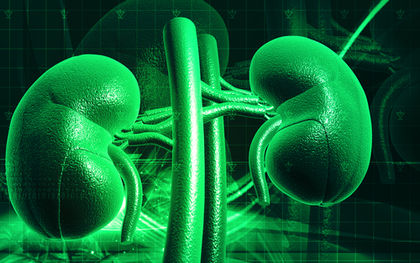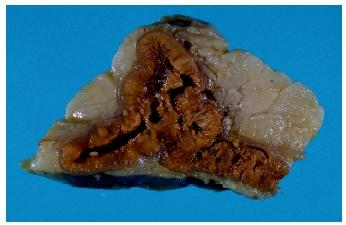Adrenal Gland

The adrenal glands are located on the upper pole of each kidney. In fact, their name designates their location: the prefix ad means "adjacent," and renal refers to the kidney. In the human body, they are small yellowish glands that weigh about five grams (0.175 ounces) each.
The adrenal gland is actually two organs in one. The outer portion, called the adrenal cortex ( cortex means "bark," as in the bark of a tree), is about nine-tenths of the gland's total weight. The inner part, called the adrenal medulla ( medulla means "marrow," as found in the inside of a bone),

Adrenal Cortex
The adrenal cortex develops from the mesoderm (middle layer) of the embryo. The tissue destined to become the adrenal cortex aggregates near the developing kidney and becomes organized into three zones. The outer zone is called the zona glomerulosa (meaning that the cells are arranged in little balls called glomeruli), the middle zone is the zona fasiculata (the cells are in parallel fascicles or bundles), and the zona reticularis (reticular means network) is innermost.
The hormones secreted from each zone all resemble the molecule cholesterol and are called steroids , but each zone secretes slightly different hormones. The zona glomerulosa secretes hormones that influence the kidneys to excrete or retain sodium and potassium, depending on the needs of the body. These hormones are called mineralocorticoids (sodium and potassium are minerals ). The zona fasiculata secretes hormones called glucocorticoids that influence the metabolism of carbohydrates , including glucose . The glucocorticoids include hydrocortisone, corticosterone, and cortisone.
In addition to regulating metabolism, these steroids provide resistance to stress and suppress the inflammatory response and some allergic reactions. Steroids such as these are often rubbed onto inflamed and itchy skin to make it feel better. The zona reticularis secretes steroids that resemble the sex hormones secreted by the ovary in the female and testes in the male.
The adrenal cortex is regulated by the pituitary gland in the head. The pituitary gland secretes a hormone called adrenocorticotropic hormone (ACTH). Tropic (pronounced with a long o) is from a Greek word meaning "nourishment," so ACTH simply refers to this hormone's ability to produce a change in the adrenal cortex. ACTH is necessary for cell growth and maintenance and stimulates glucocorticoid synthesis.
Adrenal Medulla
The adrenal medulla forms from ectoderm (outer layer) very near the embryonic spinal cord. From its beginnings, the adrenal medulla is part of the nervous system. These cells migrate into the middle of the developing adrenal cortex and form into a solid ball. The cells of the adrenal medulla secrete a class of hormones called catecholamines, adrenaline (or epinephrine) being the best known. Norepinephrine is also secreted.
In times of acute stress, the brain and spinal cord send a signal to the adrenal medulla, and it secretes adrenaline into the bloodstream. This causes the heart to beat faster, opens up the airways, and gets the body ready for physical activity. This "fight or flight" reaction is a survival mechanism, allowing people (and other animals) to escape from a dangerous situation. A person experiences the effects of the adrenal medulla when he or she gets scared or excited.
Why is the adrenal medulla inside the cortex? Steroids in the adrenal cortex activate the enzyme that puts the final atoms onto adrenaline. Therefore, the adrenal cortex helps the adrenal medulla to synthesize adrenaline, allowing the medulla to do its job.
SEE ALSO Anabolic Steroids ; Endocrine System ; Homeostasis ; Hormones ; Pituitary Gland ; Stress Response
Stephen W. Carmichael
Bibliography
Carmichael, Stephen W., and Hans Winkler. "The Adrenal Chromaffin Cell." Scientific American 253 (August 1985): 40–49.
Ross, Michael H., Lynn J. Rommerell, and Gordon I. Kaye. Histology: A Text and Atlas, 3rd ed. Baltimore: Williams & Wilkins, 1995.
Comment about this article, ask questions, or add new information about this topic: